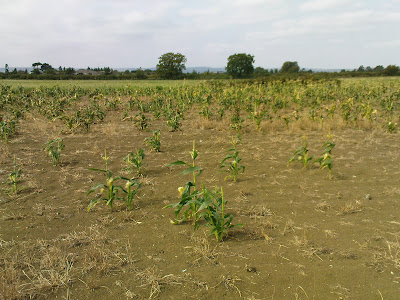
This is Beethoven, the highest yielding variety in it's class on the NIAB list. This sequence is the harvesting of the crop whose pictures appear in an earlier blog of mine charting the crops growth stages.
Some farmers will be shocked, or surprised at how green the crop appears, saying it was harvested way too early, being cut on the 5th of October.
Now, there would appear to be a fair amount of incorrect information being dispensed by certain people not familiar with the stay-green concept of most LG varieties, you only have to look at photo's of harvesters in Holland, or Denmark cutting maize which is as green as this, they don't seem to have any problems with it.....The issue is cob maturity, as well as soil type related.
This is fairly dry, free draining soil, so the amount of water in the stems is that much less than that on heavier clay soils. Looking closely at the sheaves of the cobs, it can be noticed that they are all brown and drying off, when the cobs were snapped in half, the kernels were hard cheese almost down to the bottom where there was a little bit of milk/soft cheese

, importantly the grains on the cob were shiny, but not flint hard. This is important, as I have seen quite a lot of maize that has been left in the field till the grains were flint hard, especially maize under plastic. The problem with letting this get to this stage is that there is a high risk of the cows' gut not being able to digest these very hard grains even if they have been through the cracker on the forager. Seems pointless to go for a high drymatter, if the cow isn't going to get the full benefit of all the feed.
The issue of maturity of the crop is important, because where crops have been planted later (15th May onwards), I have noticed that they were still not mature in the cobs by the end of October, even though the leaves were dying back (due to frost and the very cool nights). Given maize needs to photosynthesize right the way up to cob maturity before dry down commences, it is important to get the cobs mature on the plant, before this happens. Immature cobs, no matter how dry the plant is from a dry mature point of view, is always going to produce very acid, poor quality silage. Unfortunately, it is the way in which NIAB works out the dry matter values at harvest that causes some varieties to be placed in catergories that don't accurately reflect their harvest dates. In trials this year, where a range of maturity classes from 5 to 10 have been grown all in the same field, the diffrences in maturity to harvest was 10 days between the earliest to the latest, with some group 5 varieties being ready to harvest at the same time as some 9's. Harvest dates on the list should be measured as a race to 32% DM, this would then allow better differentiation of varieties on the recommended list.

Happy grower! Silage in the clamp has come back at 30% DM and 32.5% Starch, the yield was conservatively worked out at 22ton/ac as with only 4 trailers running the driver on the forager was filling the trailers to brimming to enable them to keep up.

Nice consistant crop height, even cob height,even maturity, dwarfed forager.....that's what we should be aiming at when growing maize!










































